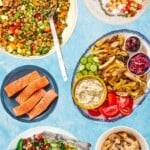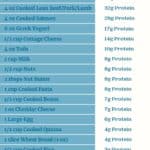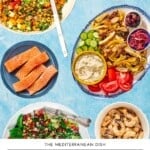If you’ve ever asked yourself, “How much protein do I need and do I need to eat protein bars and powders to fill that need?” you’re not alone! Ellie Krieger, RDN, is here to help you understand just how much protein you need and the whole-food ways to get it.
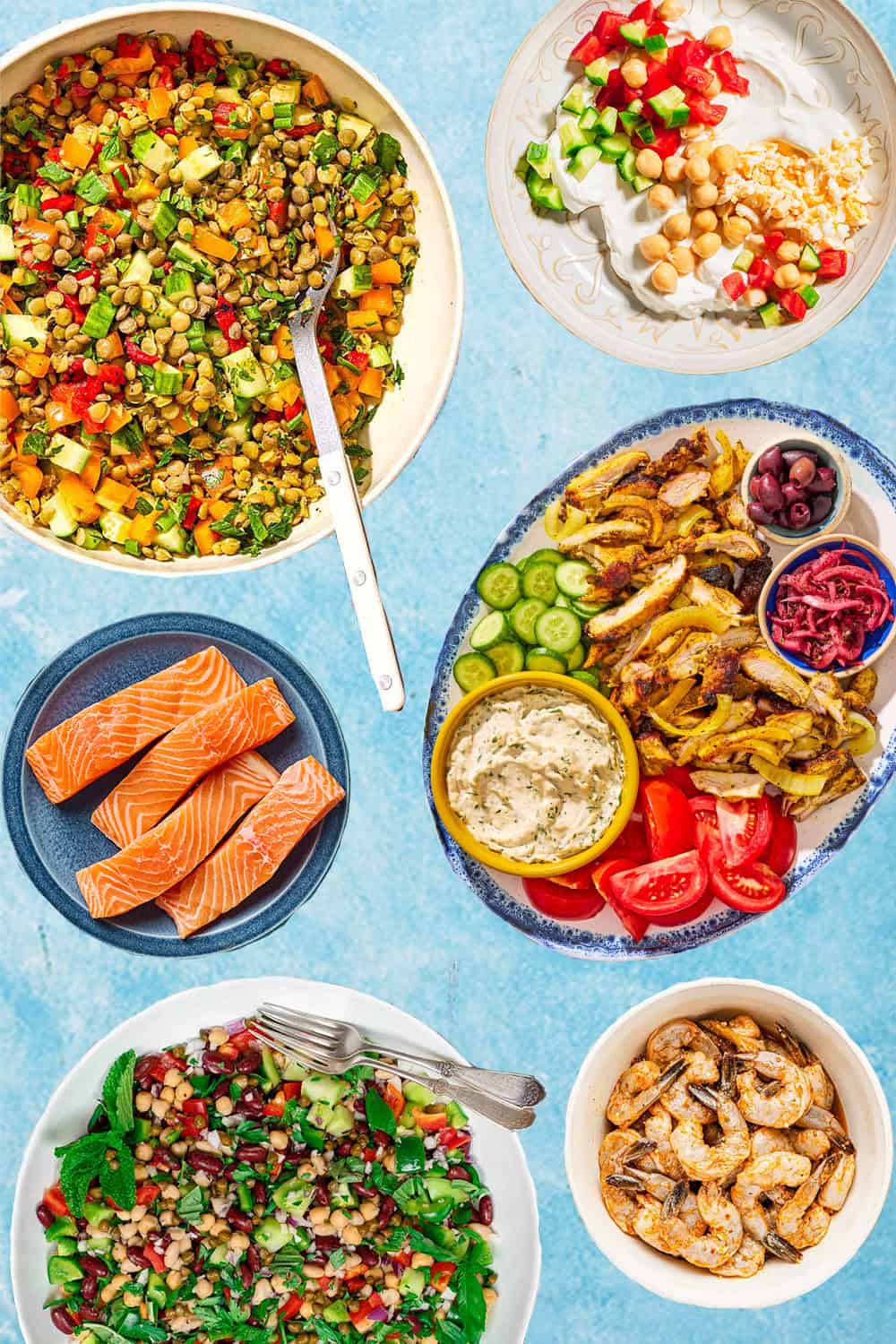
A trip around the grocery store is all the evidence needed that we have gone protein crazy. Manufacturers slap the word on practically everything—protein potato chips, protein waffles, protein cookies, and protein snack bars galore. Apparently, a sprinkling of protein powder is all that’s needed to give a food a health halo.
Then there is the guy in front of me in line at the café at my gym who ordered three chicken breasts for lunch. That’s it, just three grilled chicken breasts. And I will never forget the story my sister told me about when she was pregnant with her first child.
She had finally collapsed into bed after a long, tiring day. But before she drifted off to sleep she reviewed her food diary and realized she had eaten only 85 g of protein that day, instead of the 100 g she had read somewhere that she needed. So, even though she was not the least bit hungry, she got out of bed, went downstairs, and force-fed herself a cup of cottage cheese while standing half-awake in front of the refrigerator. (She stopped counting grams of protein with her second pregnancy.)
Protein is more than important, it’s essential. But from what I can tell we have tipped into unhealthy territory when we are eating piles of chicken for lunch, force-feeding ourselves cottage cheese before midnight, and thinking fried chips are good-for-you if they contain protein powder.
I thought I’d put things in perspective here so you can be confident you are getting enough of this essential nutrient without falling into any of these unhealthy traps.
Table of contents
Protein 101
Protein is critical to the health of every cell in our bodies. It is necessary to:
- Build and maintain muscle and other tissues
- Create red blood cells
- Keep hair, skin, and fingernails healthy
- Help produce antibodies and keep our immune systems running strong
- Help us stay fuller, longer after a meal
- Temper rises in blood sugar when eaten with carbohydrate-rich foods
Protein is made up of chains of amino acids. There are 20 amino acids we need for survival, but our bodies can make 11 of them, so that means that we need to get the remaining 9 “essential amino acids” from the foods we eat.
If a food contains all 9 essential amino acids in ample amounts it is considered a complete protein. The following are examples of complete proteins:
- Meat (beef, veal, lamb, pork, goat, and venison)
- Poultry
- Fish
- Eggs
- Milk
- Cheese
- Soy foods such as tofu and edamame
Beans, nuts, seeds, and grains are incomplete proteins on their own, but they complement each other to provide all the essential amino acids and they are among the most healthful foods you can eat and. You do not have to eat them at the same meal to add up to a complete protein.
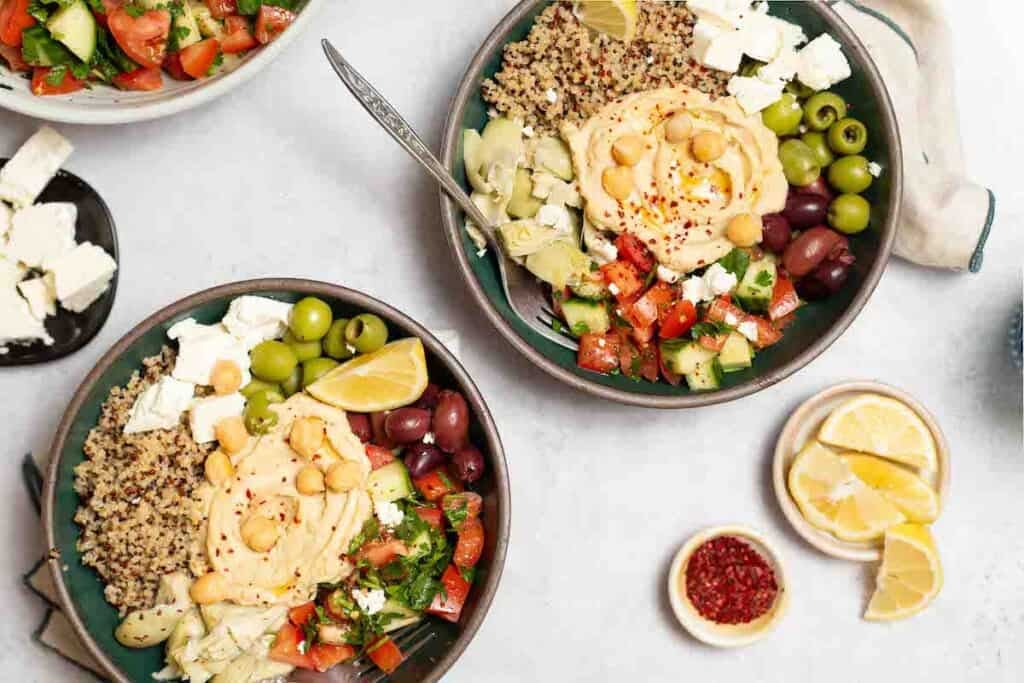
How Much Protein Do You Really Need?
Your daily protein need depends on your activity level, weight, age, and other factors, such as if you are nursing or pregnant.
The recommended dietary allowance (RDA) for protein is .36g per pound body weight (.8g per kilogram), which equals 54g of protein per day for a 150-pound person.
However, the RDA is the amount of protein needed to prevent deficiency. It is not necessarily the optimal amount.
Research shows that optimal protein intake—the amount needed to maximize muscle growth with resistance training and minimize the muscle loss related to aging and that comes with weight loss—is about double the RDA, at .54g to .9g of protein per pound body weight (1.2 to 2.0 g per kilogram).
That translates to 81g to 135g of protein per day for a person weighing 150 pounds. Most Americans don’t have to try too hard to get that much—it is in the range of what we are already consuming.
Here are the protein contents of some foods, and an example of a typical day, so you can get an idea of how it can add up:
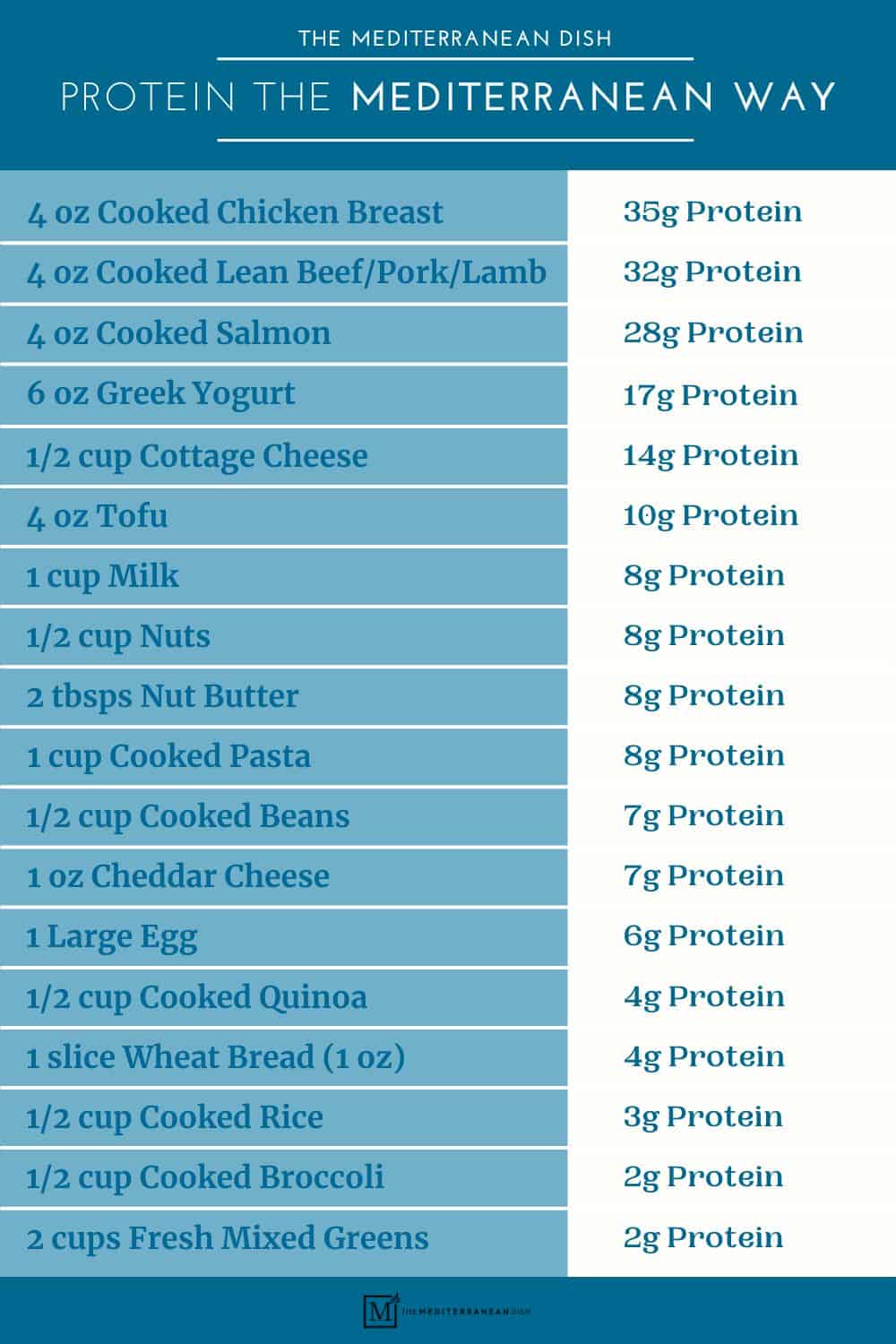
Sample Menu for Eating 132g Protein Per Day
Here is an example of how a day of optimal protein eating could look:
- Breakfast: Greek yogurt with nuts and fruit (25g)
- Snack: Smoothie with milk and nut butter (18g)
- Lunch: Green salad with 4 oz. salmon and a piece of bread (34g)
- Snack: 1/4 cup hummus and vegetables (8g)
- Dinner: 4 oz. chicken with rice, beans and broccoli (47g)
- Total = 132g protein
As you can see, there is no need to eat piles of chicken breast on their own or force-feed yourself to meet your protein gram target on any given day. Those behaviors can actually be dangerous, bordering on obsession and taking the balance, pleasure, and self-nurturing out of meal-time.
Rather, take a wider-angle view, knowing that a lower-protein meal or day now and then won’t throw you off. You will likely stay in the optimal protein zone if, for the most part, you simply focus on including at least one protein-rich food in each of your meals and snacks, and aim to get more at breakfast.
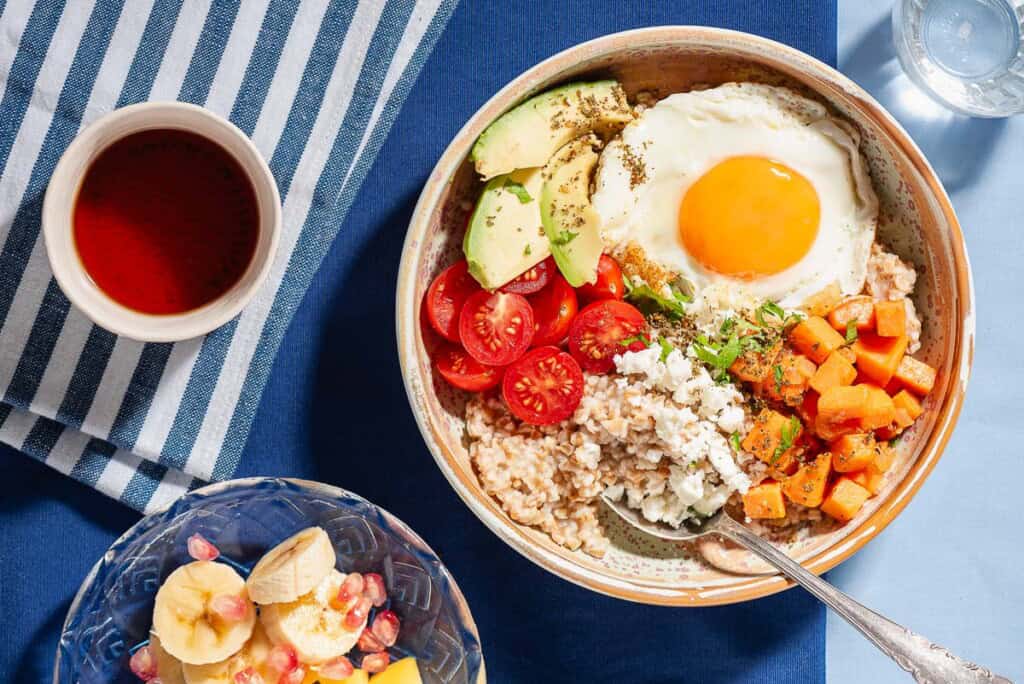
When is the Best Time to Eat Protein?
While most of us get plenty of protein overall, where we could improve is by shifting when we eat our protein. We tend to get the bulk of it at dinner, but distributing it more evenly throughout the day could be a gamechanger as we get older.
Getting 25-30 grams of protein at lunch or dinner is generally not a push. A palm-sized piece of chicken or fish, or a bowl of lentil soup and a hunk of bread will get you there. It’s breakfast that can be more challenging because it means starting your day with a more substantial meal than you are likely used to.
To get enough protein at your morning meal try having a cup of Greek yogurt or cottage cheese with your usual toast (try this Seeded Whole Wheat Bread Recipe), add a few ounces of salmon or tuna salad to a bagel and cream cheese, and prepare your oatmeal with milk or soymilk and add a generous helping of nuts to the bowl.
As we age, our bodies become less efficient at building and maintaining muscle. Starting at about age 30 we begin to lose muscle at the rate of roughly 1 percent per year. Over the course of several decades that muscle loss can really add up and lead to a lack of independence later in life.
But distributing protein more evenly throughout the day can help stem that tide. Research shows that eating a minimum of 25-30 grams of protein at a meal can help stimulate muscle synthesis in older people.
Exercise also sparks muscle building. By getting enough protein at each meal and staying active, ideally incorporating strength training, we have a good shot at maintaining more of our muscle throughout our life span.
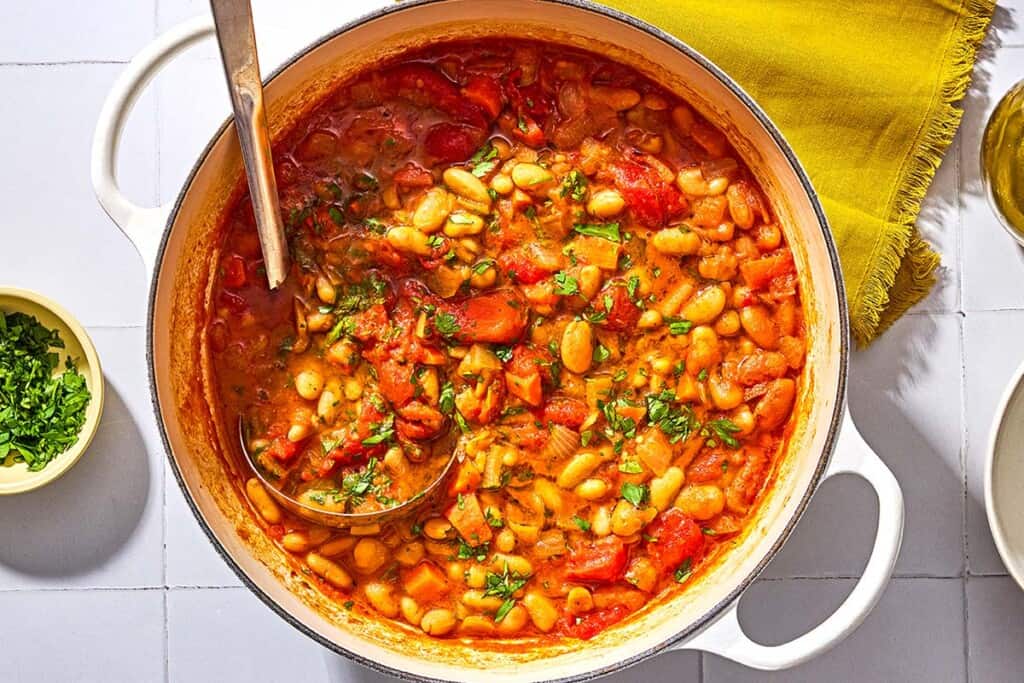
More Doesn’t Mean Better
Eating more protein daily than the higher end of the optimal range (.9 g per pound or 2 g per kilogram per day), as many online diets will have you do, isn’t any better for you, and it could be detrimental.
Going to such an extreme with protein edges out other nutritionally important foods, such as vegetables, fruits, and whole grains. Excess protein over time can also lead to digestive issues, and it stresses our kidneys, which is not an issue for healthy people but can be for those with compromised kidney function.
Consider the Whole Package
The proteins we eat are more than just that single macro-nutrient, they are complex foods that offer multiple benefits in terms of flavor, texture, and nutrition.
So see them for the whole package they offer, opting for those you enjoy most that are minimally processed and have lower amounts of saturated fat. Aim to incorporate more beans, nuts and seeds, seafood, whole grains, yogurt, poultry, and lean meats, and eat fewer fatty, processed meats.
Protein powders could help you meet your protein needs, but I suggest using them only occasionally, if at all, and leaning into more naturally nutrient-dense, whole foods whenever possible. Keep in mind that chips and cookies with added protein are still chips and cookies—so ignore the marketing and just go for the kind you truly prefer.
This article is syndicated from Ellie Krieger’s Substack newsletter, where she provides trustworthy information on trending food and nutrition topics. Subscribe for free here. Ellie, a registered dietitian nutritionist and two-time James Beard award-winning cookbook author, is well known from her hit Food Network show Healthy Appetite, and her PBS show Ellie’s Real Good Food.
References
- Protein intake trends and conformity with the Dietary Reference Intakes in the United States: analysis of the National Health and Nutrition Examination Survey, 2001-2014
- Dietary Protein and Muscle Mass: Translating Science to Application and Health Benefit
- Exercise and nutrition to target protein synthesis impairments in aging skeletal muscle
- Dietary protein recommendations and the prevention of sarcopenia
